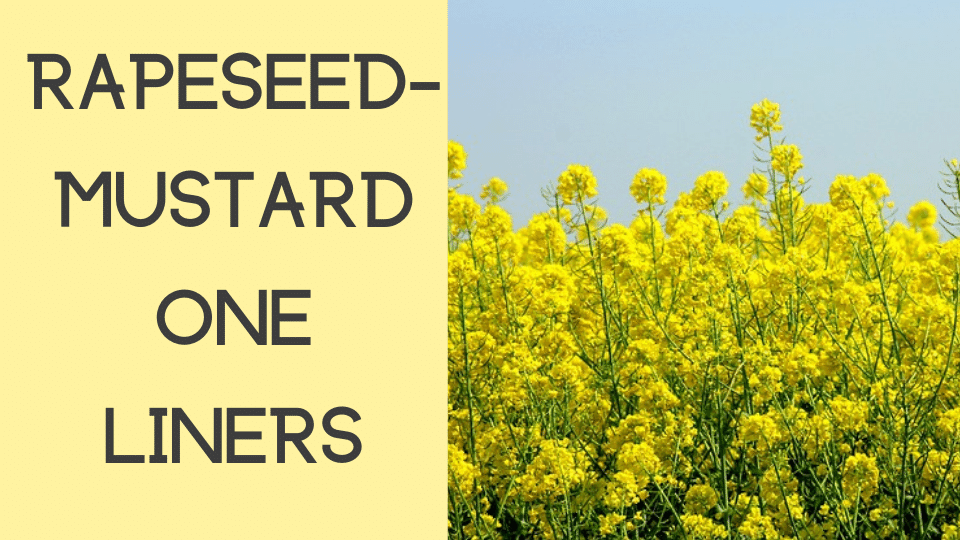- August 15, 2021
- Team CrackAgri
- 0

Rapeseed-Mustard One Liners
Q. Botanical name of Rapeseed-Mustard
Ans. Brassica spp (White mustard: Brassica Alba)
Q. Centre of origin:
Ans. Asia Minor and China
Q. Pungency in mustard oil due to
Ans. Glucosinolates or Allyl-isothiocyanate
Q. Oil content:
Ans. 37 to 49% (High in yellow sarson 42-1%, toria 41%)
Q. Highest producing state:
Ans. Rajasthan
Q. First tolerant variety
Ans. Swarna jyothi
Q. Highest productivity of Rapeseed-Mustard in India
Ans. Haryana
Q. Fruit of mustard is called
Ans. Siliqua
Q. Protein content
Ans. 24-30%
Q. Seed rate
Ans. 3-5-10 kg/ha
Q. Yield rate
Ans. 500-800 kg/ha
Q. Varieties
Ans. Sangam, Type-9, Type-36, Brown BSH-1,
Pusa Kalyani, Suphala Yellow, Jhumka
Q. Disease caused by regular use of mustard cakes
Ans. Goiter
Q. Upper limit fixed by Govt. for Glucosinolates in mustard oil is
Ans. 0.5%
Q. Type of rapeseed
Ans. Brown Mustard and Yellow Mustard
Q. Botanical name of Indian mustard
Ans. Brassica juncea
Q. Indian mustard also known as
Ans. Rai
Q. Varieties of Indian mustard
Ans. Krantí, Varuna (T-59), Rohini, Pusa bold
Q. New released varieties of mustard
Ans. Laxmi, Vasundhra, Ashirwad, Basanti, Pusa Jai Kisaan.
NRC-HB-5-6, DMH-1, RH-0408
Q. Mustard Variety which has first developed through biotechnology
Ans. Pusa Jai Kisaan (Bio-902)
Q. Variety suitable for late sowing irrigated area
Ans. NRCHB-101
(Variety of Indian Mustard by Pusa Mustard-26, Pusa Mustard-27, Pusa Mustard-28
Q. Nutrient which is essential for mustard
Ans. Sulphur
Q. Major pest of mustard
Ans. Mustard Aphid & Mustard saw fly
Q. National research centre for mustard is situated at
Ans. Bharatpur (Rajasthan)
Q. Various varieties:
Ans. 1. Brown sarson Pusa Kalyani, KOS-1, KBS-1
2. Yellow sarson – Jhumka
3. Mustard Varun, Pusa Bold, Bandan, Pusa kranti
Q. Important diseases
Ans. Alternaria blight white rust downy mildew and stem rot.
